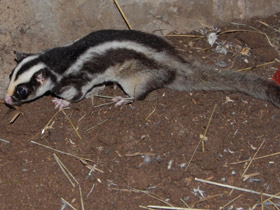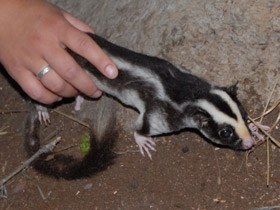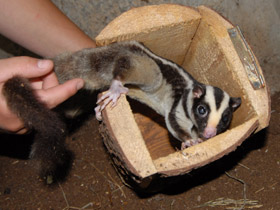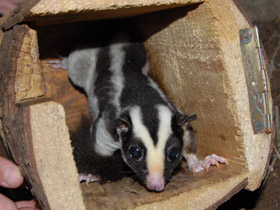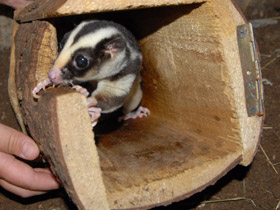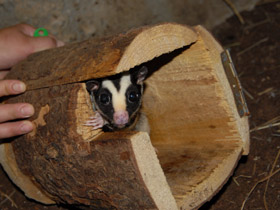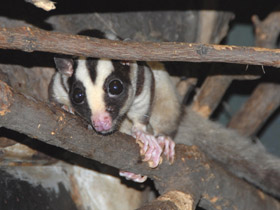The family Petauridae
The striped possum or common striped possum (Dactylopsila trivirgata)
Petauridae is a family of possums containing 11 species: four species of trioks and striped possum (genus Dactylopsila), six species of wrist-winged glider (genus Petaurus), and Leadbeater's possum (Gymnobelideus leadbeateri), which has only vestigial gliding membranes. Most of the wrist-winged gliders are native to Australia, whereas most of the striped possums to New Guinea, but some members of each group are found on both sides of the Torres Strait. Leadbeater's possum is endemic to Victoria, Australia.
Taxonomy
The listing for extant species is based on The Third edition of Wilson & Reeder's Mammal Species of the World (2005), except where the Mammal Diversity Database and IUCN agree on a change. The family consists of the following three genera and 11 species:
- Genus Dactylopsila:
- Great-tailed triok, Dactylopsila megalura;
- Long-fingered triok, Dactylopsila palpator;
- Tate's triok, Dactylopsila tatei;
- Striped possum, Dactylopsila trivirgata;
- Genus Gymnobelideus:
- Leadbeater's possum, Gymnobelideus leadbeateri;
- Genus Petaurus:
- Northern glider, Petaurus abidi;
- Yellow-bellied glider, Petaurus australis;
- Biak glider, Petaurus biacensis;
- Sugar glider, Petaurus breviceps;
- Mahogany glider, Petaurus gracilis;
- Squirrel glider, Petaurus norfolcensis.
The striped possum or common striped possum (Dactylopsila trivirgata)
The striped possum or common striped possum (Dactylopsila trivirgata) is a member of the marsupial family Petauridae. It is found mainly in New Guinea. The species is black with three white stripes running head to tail, and its head has white stripes that form a 'Y' shape. It is closely related to the sugar glider, and is similar in appearance.
Taxonomy
The striped possum was first described by John Edward Gray in 1858 from a specimen sent from the Aru Islands (in Indonesia) to the British Museum by Alfred Russel Wallace. Gray gave the species the name Dactylopsila trivirgata in 1858, the name the species retains today. The illustration that appeared alongside the first description was produced by Joseph Wolf.
Appearance
Dactylopsila trivirgata is a species of diprotodontid marsupial in the family Petauridae. It is one of the least known of the marsupials.
Dactylopsila trivirgata is common in northeast Queensland, New Guinea and some adjacent islands. Body length varies from 17 to 32 cm and tail length from 20 to 40 cm.
They are slightly squirrel-like in appearance. Their ears are medium-sized, triangular; the tail is long and densely covered with hairs, except for the bare, grasping undersurface. The toes of Dactylopsila trivirgata are long and slender, especially the fourth toe of the forelimbs, which also has an elongated, curved claw.
The coat colour is white or cloudy grey (each animal has an individual colour) with three black longitudinal stripes, the middle one running from the forehead to the base of the tail and the lateral ones from the corners of the mouth, through the eyes and ears to the base of the tail. Males usually have a large black spot on the chin. However, these characteristic markings are absent in females and male offspring: until they grow up, their fur is yellowish and monochromatic and they are not visible at all in the foliage where they hide. The eyes of Dactylopsila trivirgata are usually black or brown, but occasionally red or even light blue.
Lifestyle and nutrition
The activity of Dactylopsila trivirgata is nocturnal. They spend the day in tree hollows, where they make nests of dry leaves. They sleep curled up in a ball, lying on their side, not sitting like most possums. At dusk, Dactylopsila trivirgata will leave the nest in search of food. They move with their long legs so nimbly and smoothly, as if they were flowing along the branches, rather than hopping.
They feed mainly on insect larvae, which they pick up from under the bark of trees with a claw on their long fourth toe, stamping first on the trunk to scare the insects away. Catching the slightest movement under the bark, it uses its protruding incisors to tear off the top layer of bark, and then uses its elongated fourth toe to reach the larvae. At the end of this unusual finger is a sharp, hooked claw that Dactylopsila trivirgata uses to pull prey from even the smallest crevices in the bark. These marsupials also feed on pollen, wild bee honey, fruits and young shoots. Their diet probably includes bird eggs and a variety of small invertebrates.
Behaviour and reproduction
In case of danger, Dactylopsila trivirgata emits characteristic, piercing guttural cries. Little is known about the social behaviour of these animals. They are usually solitary and only form pairs during mating. Dactylopsila trivirgata is often aggressive towards other individuals.
The sexual behaviour of Dactylopsila trivirgata is also poorly studied. Mating takes place from February to August. The female has a well-developed pouch that hides the two nipples. Pregnancy lasts 13 days and two, rarely four, young are born. The female carries the young on her back for a long time, and in total the young Dactylopsila trivirgata remains with the mother for over a year. The maximum recorded lifespan in captivity is up to 4 years and 5 months.

















